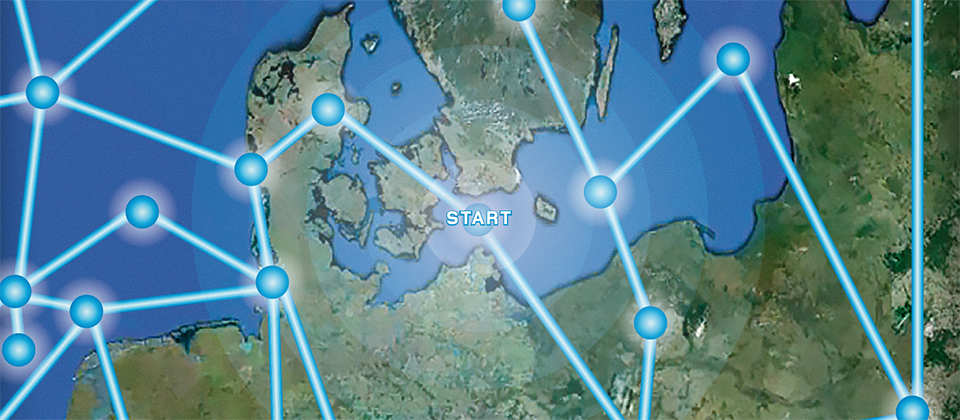
In 2014, construction will begin at Kriegers Flak, the site of the first offshore wind farms to enable electricity trading between countries. Will it all end as an isolated project connecting Germany and Denmark – or is this the start of something much more significant?
Sometime before 2020, electricity will flow from new offshore wind farms located in a part of the Baltic Sea where three countries: Germany, Denmark and Sweden, have each allocated a large area for offshore wind development. Denmark alone expects its Kriegers Flak wind farm, once completed, to double the country’s current wind power capacity.
But it’s not so much the extra capacity that’s of interest here – instead, the excitement centers upon what may be the beginnings of the eagerly awaited “Supergrid”.
Optimised advantages
Kriegers Flak will connect the offshore wind farms of two nations – Germany and Denmark, following the 2013 withdrawal of Sweden’s Vattenfall – for the very first time, enabling their output to be traded. And the projected benefits are convincing, including a more stable and flexible supply, and lower power prices.
Importantly, interconnection will optimise offshore wind investments, enabling wind farms to keep on generating electricity in windy periods instead of having their production curtailed to avoid overloading the national grid. In less windy times, individual countries may also be less reliant on fossil fuel sources to fill demand gaps.
Naturally, with advantages like these, the project is enjoying €150 m in support from the EEPR (European Energy Programme for Recovery).
Cost reduction driver
Mainstream Renewable Power CEO and renewables champion Eddie O’Connor is in no doubt about the need for renewable energy sources in general and the construction of a European supergrid, with a strong offshore wind component, in particular.
“Where will power be generated in Europe in the years to come? It can’t take up the land, so offshore wind, really, is the answer,” he says.
“While solar has a contribution to make, it isn’t the answer to the sustainable energy challenge. But offshore wind at scale brings costs down – and the Supergrid is what will make this happen.”
Eddie sees the Supergrid as a key driver in reducing electricity prices to the consumer:
“There are still many national markets – a single market would be of tremendous value to the customer. From the customer’s viewpoint, wind has a zero incremental cost. That’s good, because the more wind there is, the cheaper power becomes. But offshore wind has high fixed costs that need to be covered.
“Linking up the whole of Europe moves the dial in favor of incremental costs. You can still tap into sufficient capacity via fossil fuels but you also let people far from major centers share in the low variable cost of wind. This is a model I believe will reduce the price of electricity for the average customer in Europe. And it simply can’t be done without the supergrid.”
A force for good
“If we’re going to achieve the transition to sustainable energy, then the Supergrid is absolutely vital. There’s no alternative,” he claims.
“Just look at shale gas. It’s a fossil gas that’s dirtier than coal. The gas lobby say you can replace coal with it, but in the US, coal employment has risen since shale opened, with mines being dug even deeper. Europe, too, has invested more in coal since the entry of shale. In my opinion then, shale encourages the development of coal. The Supergrid can’t get here soon enough to help us avoid further increases in fossil-based infrastructure.”
Eddie isn’t content just to talk about the challenges. He’s the founder and president of Friends of the Supergrid (www.FOSG.com), assembling companies such as ABB, Siemens, Alstom, Prismian, RTE National Grid, REN, Ilia and others.
He is convinced that the group has the knowhow and resources to advise on the design and development of the SuperGrid, and FOSG is actively lobbying to push its agenda forward at EU and national levels. Mainstream Renewable’s CEO is also concerned by the impact of the transition to renewables on companies such as RWE or Eon.
“They are losing money on their fossil fuel generators. For example, the UK is incentivizing new gas plant build, while RWE, for instance, is closing down gas plant in Germany. Instead, use could be made of existing capacity in one country to meet the electricity demand in another.
“In this way, the capacity factors for the existing plant would increase and make profit for the company that owned the plant, and the other country would not have to invest in new plant. The net result would be cheaper electricity for consumers at both ends of the Supergrid.”
His passion for sustainable energy is unmistakable:
“The US is attempting to build its economy on shale gas. Gas is one of the major inputs to the coal industry, and we see an extra 20,000 people being employed in coal manufacture since shale gas ramped up.
“Once the US starts exporting gas, pricing will move to a world price. Fossils include gas as well as coal. Burning 1 tonne of coal releases 2.8 tonnes of CO2. When 1 tonne of natural gas is burned, 2.6 tonnes of CO2 are released. Just look at the massive damage the climate change is inflicting on the planet. We pay a high price for this now, but we will be paying a much higher price in the future.”
Birth of the European supergrid?
A converter platform and two 150 Kv sea cables approximately 15 km long will connect the new Danish 600 MW wind farm with Baltic 2 – a 288 MW wind farm owned by Germany’s EnBW.
The modular solution can be extended to incorporate other wind farms and national markets. The key drivers of the project are German transmission system operator 50 Hertz Transmission and Denmark’s Energinet.
Like this post? Subscribe now and get notified about new content!

Pingback: World’s Cheapest Offshore Wind Farm to Power 600,000 Homes – Green Energy Tribune